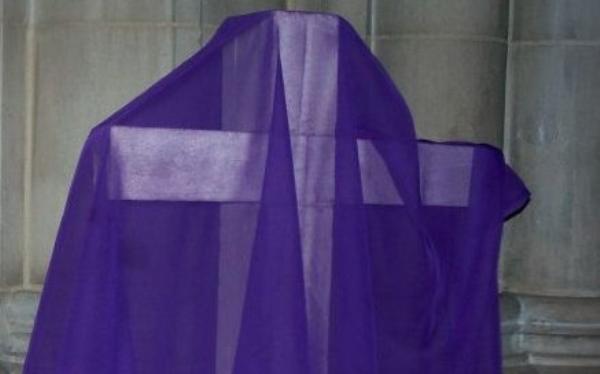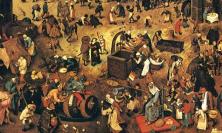As we each find our own ways to mark the season of Lent, we follow in the footsteps of centuries of Christians who have spent time preparing to celebrate the resurrection of Christ. How did the Church's understanding of the forty days of Lent change between the Council of Nicaea in the 4th century and the Second Vatican Council? Church historian Norman Tanner SJ gives a short history of this time of joy and preparation.
The earliest mention of Lent in the history of the Church comes from the council of Nicaea in 325 AD. The council of Nicaea is best known for the profession of faith – the ‘Nicene Creed’ – which is still recited in most parishes every Sunday immediately after the sermon. However, the council also issued twenty canons of a practical nature, dealing with various aspects of church life, and the fifth of these canons speaks of Lent.
The word used for Lent in this fifth canon is tessarakonta (in the original Greek), which means ‘forty’. For the first time in recorded history, we have mention of this period of preparation for Easter as lasting forty days. Much earlier, Christians had introduced Easter Sunday to celebrate Christ’s resurrection. Soon afterwards, a period of two or three days preparation, specially commemorating Christ’s passion and death – the ‘Holy Week’ part of Lent today – had been adopted by various Christian communities. But the first mention of a preparatory period lasting the forty days comes from this fifth canon of Nicaea.
The length of time was adopted in imitation of the forty days that Jesus spent in the desert at the beginning of his public ministry:
Then Jesus was led up by the Spirit into the wilderness to be tempted by the devil. He fasted forty days and forty nights and afterwards he was famished. (Matthew 4:1-2)
In many languages the word for Lent implies ‘forty’: Quaresima deriving from quaranta (forty) in Italian; Cuaresma coming from cuarenta in Spanish; Carême deriving from ‘quarante’ in French. The English word ‘Lent’ has another, very beautiful derivation. It comes from the Anglo-Saxon (early English) word meaning to ‘lengthen’. Lent comes at a time when the hours or daytime are ‘lengthening’, as spring approaches, and so it is a time when we too can ‘lengthen’ spiritually, when we can stretch out and grow in the Spirit.
We should not, therefore, place too much emphasis upon our own efforts. Just as the sun was thought to do the work of ‘lengthening’ the days during early Springtime, so it is the sun – in the sense of God’s warmth and light – that does this work in our ‘lengthening’ and growing in Christ. In the English language, indeed, we have a beautiful play on the words ‘sun’ and ‘son’, which are pronounced identically. Just as the sun was seen to do the work of ‘lengthening’ the days in spring, so it is the Son of God, Jesus Christ, who does the work of ‘lengthening’ in our spiritual growth. This image provides a comfort for us in our busy modern world, where hyperactivity can become the norm. Our role during Lent is to cooperate with God’s grace and initiatives, in a sense to relax in the presence of God, rather than to force the pace with our own efforts.
Scripture and the early Church suggested a variety of ways in which this ‘lengthening’ might come about, a variety of ways in which we can cooperate with God’s grace. The passage from chapter 4 in Matthew’s Gospel, just mentioned, emphasised the role of fasting. Canon 5 of the council of Nicaea emphasised rather the importance of forgiveness and harmony within the Christian community. Thus a synod (local church council) was to be held ‘before Lent so that, all pettiness being set aside, the gift offered to God may be unblemished’. Various other features of Lent came to be drawn in, as we shall see.
Lent is very ecumenical. At the time of the council of Nicaea, the Church was still united, East and West. We are long before the sad division of the Church into Catholics and Orthodox, which came about in the eleventh century. Indeed the council of Nicaea belongs principally to the Eastern Church: the city lies in modern Turkey. Most Protestant churches recognise the authority of the early councils and therefore, at least tacitly, the canons of Nicaea. Article 21 of the Thirty-Nine Articles of the Church of England, in the form first promulgated in 1563, states explicitly that respect should be given to the council of Nicaea. In keeping Lent, therefore, Christians can celebrate the Eastern roots of their faith. They can rejoice, too, that despite the sad divisions which still remain, unity among them is fundamental. Christians are much more united than divided.
It is important to remember that Lent is a joyful season. The first Preface for the Mass in Lent makes the point very elegantly:
Each year you give us this joyful season
when we prepare to celebrate the paschal mystery
with mind and heart renewed.
You give us a spirit of loving reverence for you, our Father,
and of willing service to our neighbor.
As we recall the great events that gave us a new life in Christ,
you bring to perfection within us the image of your Son.
Perhaps it is unnecessary to emphasise this joyful aspect of Lent, but the older among us may remember a more negative emphasis. As boys at school we were urged to give up sweets during Lent, and the months of February and March were quite a bleak time anyway. Various pleasures, such as watching films, were cancelled. Some asceticism is important, of course, but it is essential to place the discipline within its proper and positive context: purification so that we can receive God’s gifts more fully.
This twofold dimension of Lent – joy and preparation – is elaborated in the Second Vatican Council’s decree on the Liturgy (Sacrosanctum concilium, 109-10). The passage is worth quoting in full:
109. The season of Lent has a twofold character: primarily by recalling or preparing for baptism and by penance, it disposes the faithful, who more diligently hear the word of God and devote themselves to prayer, to celebrate the paschal mystery. This twofold character is to be brought into greater prominence both in the liturgy and by liturgical catechesis. Hence:
a) More use is to be made of the baptismal features proper to the Lenten liturgy; some of them, which used to flourish in bygone days, are to be restored as may seem good.
b) The same is to apply to the penitential elements. As regards instruction it is important to impress on the minds of the faithful not only a social consequences of sin but also that essence of the virtue of penance which leads to the detestation of sin as an offence against God; the role of the Church in penitential practices is not to be passed over, and the people must be exhorted to pray for sinners.
110. During Lent penance should not be only internal and individual, but also external and social. The practice of penance should be fostered in ways that are possible in our own times and in different regions, and according to the circumstances of the faithful; it should be encouraged by the authorities mentioned in Art. 22 [the Apostolic See and, as laws may determine, on the bishop].
Nevertheless, let the paschal fast be kept sacred. Let it be celebrated everywhere on Good Friday and, where possible, prolonged throughout Holy Saturday, so that the joys of the Sunday of the resurrection may be attained with uplifted and clear mind.
The council of Nicaea in 325 and the Second Vatican Council may be seen as the two poles in the history of Lent: Nicaea acknowledged its existence while Vatican II confirmed its importance. The sixteen centuries between the two councils saw a variety of developments in the way Christians observed this season.
At an early date, the last week of Lent – ‘Holy Week’ – became distinct and focused on the last days of Christ’s life on earth, followed by his resurrection. This was an obvious development inasmuch as the week tied in with the overall chronology suggested by the gospel writers (the precise chronology is debated by scholars). The ‘week’ begins with Palm Sunday, commemorating Jesus’s entry into Jerusalem (Matthew 21:1-9; Mark 11:1-10; Luke 19:21-38; John 12:12-18). It moves to the ‘Last Supper’ with his disciples on Maundy Thursday – ‘Maundy’ deriving from the Latin mandatum, meaning commandment, following Christ’s invitation: ‘A new commandment I give to you, that you love one another even as I have loved you’ (John 13,34) – and his prayer in the garden of Gethsemane, followed by his arrest and the beginning of his trial. Good Friday – ‘good’ in the sense that it is the day on which our redemption is realised – commemorates the bitter details of Christ’s passion: his scourging and crowning with thorns; his condemnation by Pontius Pilate; his journey to Calvary; his death on the cross; and his burial. Holy Saturday quietly remembers Christ’s time in the tomb, and Easter Sunday rejoices in his resurrection ‘on the third day’ – ‘third’ in the sense of counting Friday, Saturday and Sunday.
The long, earlier part of Lent sought to relive more directly Christ’s forty days in the desert, giving Christians appropriate time for quiet, prayer and purification. The psalms and the scripture readings which make up the Divine Office – the seven ‘hours’ of Matins (morning prayer), Lauds (Praise), Terce (third hour after sunrise), Sext (sixth hour), None (ninth hour), Vespers (evening prayer) and Compline (final prayer) – were selected to harmonise with this ‘Lenten’ spirit. The readings during Holy Week followed closely the story presented in the gospels together with suitable readings from the Old Testament and other parts of the New Testament – specially notable are the four ‘Songs of the Suffering Servant’ from the book of Isaiah (42:1-9, 49:1-7, 50:4-9 and 52:13-53:12) which provide the first readings at the Masses for Monday, Tuesday, Wednesday and Friday of this week.
Appropriate colours also came to be chosen for the vestments worn by the priests and other celebrants at the liturgical services. Purple is prevalent during Lent, the colour signifying both penance and hope; red is chosen for Good Friday, signifying Christ’s shedding of blood and his martyrdom; while the colour for Maundy Thursday as well as for the Easter vigil and Easter itself is white, celebrating Christ’s triumph. In these colours we find proper attention paid to the visible and sensitive dimensions of the liturgy and of human life.
Many of the details of the liturgy of Lent today – including the use of English and other vernacular languages rather than Latin – came about through the reforms inaugurated by the Second Vatican Council, for which we can be truly grateful. The reform of the liturgy of Holy Week, however, was largely the work of Pope Pius XII in the decade before the summoning of Vatican II. Another recent recovery from the early Church is the reception of catechumens into the Church on Maundy Thursday, which, as the celebration of the Last Supper, is a particularly appropriate day for catechumens to receive Communion (the Eucharist) for the first time. A wonderful occasion for me occurred when, during a period of teaching in Malaysia, I was privileged to witness the reception of some hundred adult catechumens, and their first Communion, during the Maundy Thursday liturgy in the parish church of St Francis Xavier in Petaling Jaya.
Vatican II explicitly linked the catechumenate and Lent. So we may appropriately conclude this short History of Lent by quoting from the council’s decree on Missionary activity:
It is to be desired that the liturgy of the Lenten and Paschal seasons should be restored in such a way as to dispose the hearts of the catechumens to celebrate the Easter mystery at whose solemn ceremonies they are reborn to Christ through baptism.
But this Christian initiation in the catechumenate should be taken care of not only by catechists or priests, but by the entire community of the faithful, so that right from the outset the catechumens may feel that they belong to the people of God. And since the life of the Church is an apostolic one, the catechumens also should learn to cooperate wholeheartedly, by the witness of their lives and by the profession of their faith, in the spread of the Gospel and in the building up of the Church. (Ad gentes, 14).
Norman Tanner SJ teaches Church History at the Pontifical Gregorian University in Rome.






